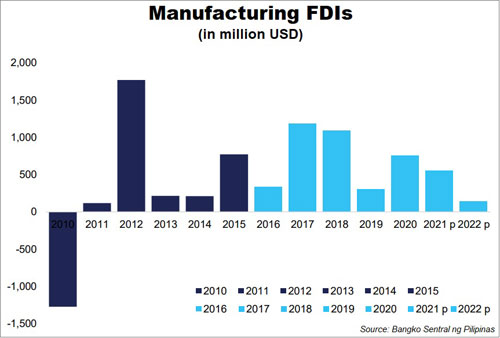Rising input costs have tempered the upside of a reopened economy, online stockbroker Colfinancial.com said.
But banks, property and consumer companies benefited the most from the loosening of restrictions, it noted, citing first quarter earnings results.
“Headline earnings of listed companies during the first quarter of 2022 improved by an average rate of 18.3 percent and a median rate of 11.1 percent. Growth would have been faster if not for non-recurring gains posted by several companies during the first quarter of last year,” it said.
Banks registered the fastest growth in profits, up by a median rate of 35.5 percent, as they benefited from the recovery in loan demand and a reduction in provisions. Property and consumer companies followed, with profits higher by a median rate of 14 percent and 13.9 percent, as both were major beneficiaries of the loosening of pandemic restrictions, Colfinancial said.
It added many of those that underperformed suffered from the impact of rising commodity prices and supply chain disruptions.
Banks
Colfinancial said banks delivered the strongest earnings performance as they enjoyed faster loan growth and booked lower provisions. Seven out of the nine banks it monitors reported higher earnings.
Colfinancial.com said banks’ median net income growth reached 35.5 percent.
“Net interest income of all banks (except one) increased as demand for loans picked up.
Banks’ median loan growth increased to percent from 4.9 percent during the fourth quarter of last year,” Colfinancial.com.
The online stockbroker also noted that six of the banks it monitors booked lower provisions due to the improving outlook of asset quality.
“Total provisions fell by 33 percent, with median annualized credit cost down to 61 basis points (bps) from 135 bps last year.
Non-performing loan (NPL) ratio of all banks, except for two, were either flat or down quarter on quarter, while the sector’s median NPL cover increased to 94.5 percent as of end March from 92.5 percent as of end December,” it said.
Realty
The recovery of malls and hotels partly offset the flattish residential business.
Property companies delivered a median earnings growth of 14 percent. Residential revenues were flat due to buyers decision to stretch payment terms and a one-off reversal of revenues related to a particular project wherein buyers opted not to push through with their purchase.
“Property companies’ takeup sales also weakened, down 2.5 percent,” Colfinancial said.
On the positive side, Colfinancial said mall and hotel revenues jumped 34.2 percent and 68.8 percent ,respectively, due to the easing of pandemic restrictions. Malls enjoyed higher foot traffic, higher tenant sales and operational gross leaseable areas, and lower rent subsidies. Hotels enjoyed higher occupancy rates.
Consumer
The impact of the high input costs was very defined in the consumer sector as the earnings recovery was weighed down by higher costs, Colfinancial.com said.
Earnings of most consumer companies improved with 10 out of the 14 companies monitored delivering higher profits – a median rate of 13.9 percent.
Restaurants and retailers benefited from the reopening of the economy.
Colfinancial.com said earnings of restaurants showed the most significant recovery with sales up by a median rate of 23.6 percent.
“However, gross margins fell slightly due to higher input costs coming from higher commodity prices,” it said.
Profits increased by a median rate of 164.6 percent.
Retailers posted a profit growth with a median rate of 32.8 percent.
“Like restaurants, revenues grew strongly by a median rate of 12.7 percent. However, unlike restaurants, most retailers were able to fully pass on higher costs, allowing margins of most to improve,” it said.
Colfinancial.com said earnings of manufacturers also grew by a median rate of 9.9 percent.
Profits increased at the slowest pace among consumer companies however as manufacturers suffered the most from higher input costs.
Manufacturers’ gross profit margin dropped by a median rate of 305 basis points.
Telecom
The sector’s core earnings rose 7.7 percent, largely driven by the strong performance of telcos’ broadband and enterprise businesses, allowing consolidated revenues to increase by 5.8 percent.
Broadband revenues jumped 19 percent as demand for wired data connection continued to increase given the still under-penetraded broadband market locally.
Enterprise revenues grew 10.7 percent as businesses continued to digitize. Mobile revenues were down 1.5 percent despite the reopening of the economy given that the industry is already highly penetrated.
Power
Colfinancial.com said power producers’ profits disappointed due to outages and other technical issues.
Excluding one-offs, power companies’ earnings rose 60.4 percent from last year.
Total sales volume rose 5.7 percent, driven by the recovery in power demand across the various segments.
Colfinancial.com said with the rebound, overall first quarter sales volume exceeded the pre-pandemic level in first quarter 2020.
Cement
Cement companies posted mixed results as they grappled with lower volumes and and higher costs.
Profits of cement companies were negatively affected by lower sales volume and higher costs, Colfinancial said.
“Revenues of cement companies were flat as sales volume fell due to the impact of Typhoon Odette, softer demand from private infrastructure projects, and the construction ban in relation to the national elections. The impact of weaker sales volume was partly offset higher average selling price (ASP) as companies raised prices,” it added.
Colfinancial.com said cement companies could not fully pass on higher input costs.





